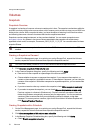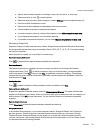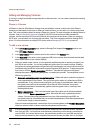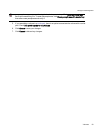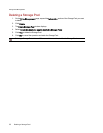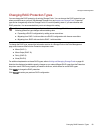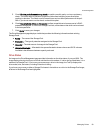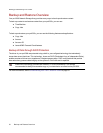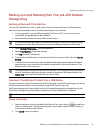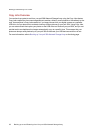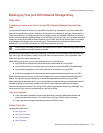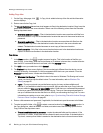
Managing Drives
The Drive Management page provides settings for managing storage and lets you apply global settings for
drives on your px4-300r Network Storage Array.
Setting Write Caching
Select a value for disk write caching.
Write caching is a mechanism that attempts to separate the fast processing speed of the px4-300r from
the relatively slow mechanics of actually writing data to drive.
With write caching disabled, every write to drive causes the px4-300r to wait while the data is written to
drive, which can slow performance. When write caching is enabled and the px4-300r sends a write request
to the drive, it writes the data to cache (which is much faster) and sends an immediate acknowledgement
to the px4-300r saying the write is complete. The system proceeds without waiting for the data to actually
get written to drive, which occurs in the background.
While write caching does improve performance, there are some risks. The system responds that the data
is written to drive when in fact it has only been written to cache. Should the px4-300r lose power, any data
not completely written to drive is lost forever.
This is because cache memory is volatile. If you lose power, the contents of the cache are lost. Therefore,
if there were any pending writes in the cache that were not written to the drive, they will be lost forever.
Using a UPS (Uninterrupted Power Supply) can mitigate the risk associated with write caching, which is
why it is recommended to only enable this feature when a UPS is connected.
Applying Global Drive Management Settings
1. Click Settings.
2. Check Add drives to storage system to add a newly installed drive. You see this option only if
there is at least one unused drive on the px4-300r.
3. To change the protection, choose a value from the drop-down menu:
● Mirror (RAID 1)
Uses half of the storage space for protection, leaving half for actual data.
● Mirror Stripe (RAID 10)
Uses half of the storage space for protection, leaving half for actual data.
● Parity (RAID 5)
Uses the space corresponding to one drive-size for protection, leaving remaining space for
storing actual data.
● Striped (RAID 0)
Distributes data across several drives in a way that gives improved speed at any given
instant.
● None
Turns off data protection and leaves your data vulnerable to data loss.
4. Select a value for disk write caching.
Drive Management
58 Managing Drives




